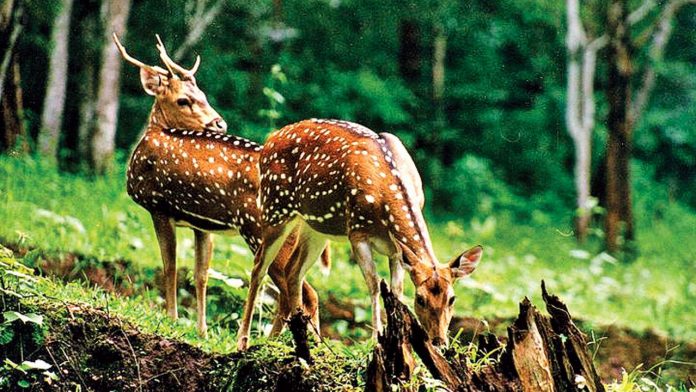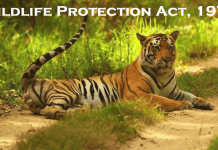This article is written by Kanya Saluja from the Institute of Law, Nirma University. The article talks about Wildlife conservation and its current scenario.
Table of Contents
Introduction
Wildlife conservation in India has a long history, going back to the pilgrim time frame when it was somewhat prohibitive to just focus on species and that too in a characterized geographical region. At that point, the formation of the Wildlife Board at the national level and authorization of The Wildlife (Protection) Act, 1972 established the framework of the present-day “wildlife conservation” period in post-free India. Henceforth, the Act has been revised a few times and the National Wildlife Advisory Board has experienced different changes.
Historical background
Project Tiger during the 1970s and the Project Elephant in 1992–both with lead species–pulled in worldwide consideration. India at that point additionally turned into an individual from all significant international conservation bargains identified with the territory, species, and condition (like Ramsar Convention, 1971; Convention on International Trade in Endangered Species of Wild Fauna and Flora, 1973; Convention on Migratory Species, 1979; Convention on Biological Diversity, 1992, among others). Today, a chain of 41 tiger stores and 28 elephant holds, other than a system of 668 Protected Areas, a declaration to the efforts of the Center. The Environmental Protection Act, 1986, and warnings gave thereunder put forth genuine attempts to secure wildlife living spaces and wildlife hallways.
With the opening up of the Indian market and procedure of globalization, the nation has gained noteworthy ground in accomplishing higher Gross Domestic Product (GDP).However, then again, improvements about the weakening of conservation efforts concerning the arrangement of administration on one side. And a noteworthy increment in the loss of life of species, joined with intercession inside Protected Areas came to force. Take, for example, the limitations by Environmental Impact Assessment (EIA) for Development Projects, covering more than 30 sections as far in 1994, shockingly overlooked all railroad projects from its ambit. The history of the most recent 20 years bears declaration to the dismal reality, in endeavours of the purported “improvement entryway” to set up rehearsals like “green barricade”. EIA notice, for example, puts extraordinary limitations for advancement projects in and around “Secured Areas”- to a great extent based on the necessity of ‘Forest Clearance’ or on the appraisal of effects on Wildlife Habitat or on very much discovered misgiving of fracture of wildlife environment or hallways.
It will be advantageous to specify that in the 31st gathering of the Standing Committee for National Board for Wildlife (NBWL), held between August 12-13, 2014, upwards of 173 projects were recorded for freedom from 24 conditions of India. An aggregate of 130 projects was cleared, however, were in the long run struck somewhere around the Supreme Court of India because the current constitution of NBWL is an infringement of law. Once more, in a solitary NBWL meeting, hung on January 21, 2015, at any rate, 34 project proposition, cutting across 12 states were endorsed; including those for street, rail, oil penetrating, pipeline, channel development all being inside the pronounced limit of 27 wildlife asylums, four national parks, one tiger stores, and two-winged creature havens, among others. Every one of these projects includes preoccupation with forest land inside the ‘Secured Area’ for a non-forestry reason.
Additionally, at any rate, 15 propositions from 10 states got freedom for redirection of forest land inside a 10 km span of national parks and wildlife asylums, which as indicated by EIA standard ought not to have been given consent. The scope of projects remembered the development of wharf for conduits and parkway ashore, storerooms, water system, trench development, street, mining, warm force, hydrocarbon investigation.
Developments
The array of advancement projects being freed might be demonstrative from the nation’s fast development, yet it additionally suggests a conversation starter—what is the eventual fate of wildlife in India? Because of illicit poaching, Sariska and Panna tiger saves in Rajasthan and Madhya Pradesh separately were as of late pronounced “tiger-less”. Buxa Tiger Reserve in West Bengal additionally has no tiger now. Late news on the death of “lions” in huge numbers in Gujarat pulled in national media consideration. Additionally, the illicit poaching or human-incited passings as seen in Manas Wildlife Sanctuary, causing a decrease in the rhino populace. In any case, then again, purposeful and anticipated passings of Indian Elephants on railroad tracks in north Bengal. Accounts of these passings that were multiple times more since the railroad line was expanded additionally pulled in eyeballs. Has any move been made to forestall such epic loss of wildlife—legitimately or wrongfully? Recently, the Government of India had again cleared another railroad project interfacing North Bengal to Sikkim using Rangpo, occupying 86 ha of forest land. These wildlife species are recorded under Schedule I of the Indian Wildlife Protection Act and ought to have been given the most elevated assurance status. The land isn’t the main spot with a wildlife emergency. Several dead ocean turtles have as of late been spotted on the Odisha coast. It is affirmed that uncontrolled trawling activity made the coast a burial ground for Olive Ridley turtles.
The 48 projects suggested for leeway in January 2015, whenever embraced, will change over 2,144 ha of forest land inside the Protected Area. Be that as it may, now and again, forest region has not been characterized and moved in such language as “afforestation of limit of Protected Area for the avoidance of part of limestone bearing mineral zone” in Kaimur Wildlife Sanctuary, Bihar. The title, at any rate, doesn’t designate “what the limestone bearing region is” that is alluded to inside the haven. In June 2015, NBWL had again cleared 18 new projects and conceded four projects without dismissing a solitary one. These incorporate six projects inside five tigers save regions. One can review how years prior, dolomite mining was completely restricted in Buxa Tiger Reserve, even though mining history goes back 50 years before the tiger save was advised.
Data collected from the survey
The forest spread in India has an objective to arrive at 33 percent of land territory however forests inside the Protected Areas have unique centrality regarding biodiversity and wildlife conservation. A long time back, an examination by the Zoological Survey of India on tiger stores of India uncovered how tiger holds have contributed towards efforts of conservation of organic diversity in the nation by securing cornerstone species and forests. One needs to recall that to date 70 percent of biodiversity has been recorded from the forested territory on the planet.
Fifteen years after a Board meeting in Gir in 2005, the Wildlife Trust of India (WTI) Board of Trustees came back to Gujarat for its 66th gathering in 2020. The area was picked in 2005 as we had quite recently propelled the whale shark battle in the state. Gujarat was picked in 2020 because of two reasons: the whale shark conservation project had a worldwide effect and The Thirteenth Meeting of the Conference of the Parties to the Convention on the Conservation of Migratory Species of Wild Animals (CMS COP13) booked the next week in Gandhinagar was an able platform to commend our prosperity with individuals from the Board and the worldwide network.
In its 21st year of activity, WTI can legitimately profess to have left an imprint in each province of India. Be it through long haul projects that we embrace in key geologies or quick transient intercessions through neighbourhood accomplices, the association has satisfied its ethos of being conservation activity situated.
Last time anyone checked, WTI has spared near 43,000 faunal lives, ensured just about 3 lakh sections of land of normal environment that incorporates coral reefs and mangroves, spared three populaces of species from neighbourhood annihilation, made seven new secured regions, furnished more than 5400 recipients with green employments, prepared more than 18,000 forest gatekeepers in India, helped the enforcement experts in leading more than 225 seizures to control illicit wildlife exchange and sharpened more than 25 lakh kids on wildlife conservation.
Established on 16th November 1998 to preserve wildlife, WTI with its four individuals ready and three representatives has since developed to one of India’s best conservation associations with more than 150 staff and a Governing Board of 10 trustees. The 150 experts on staff originate from similarly assorted foundations – conservation scholars, researchers, veterinarians, directors, legal advisors, money specialists, and correspondence experts – all attracted to work for the basic reason for wildlife. So do the ten trustees ready – their times of understanding from the fields of conservation, corporate, media, training, and the executives are brought into the mixture of the incredible administration, astuteness and bearing that they confer to this association that has recently hit the limit of a jump into the following decade.
Analysis and the current scenario
To overcome insufficiency in India’s wilds and conservationists, there are broad list of things to get off what ought to be finished. Be that as it may, taking the centre way and keeping desires reasonable, this is a pivotal chance to anticipate what should be possible with what we have.
Where populaces direct governmental issues and progress, it gets occupant for the strategy to lean towards a formative way. We can find some kind of harmony just if some political will works for sparing nature.
Conservation resembles a round of chess. You play regardless of what happens, when you realize you may lose. We can’t kick back and watch the normal world bite the dust, an unnatural passing because of some human indiscretions. Associations like WTI exist because there is such a great amount to do.
Take for instance Gujarat, where one would think there is next to no life in the parched scene of the Rann of Kutch aside from internment camps of the Agariya people group who work the salt dish. Hold up till you see the flamingos that paint the land pink, or a huge number of demoiselle cranes that sever the air with their calls, the raptors, night containers, and owls. A sanctuary for birders, this land has just a single male Great Indian Bustard left.
Impacts of electrical cables are probably the greatest danger to endangered winged animals. The thirteenth Conference of Parties of the CMS held in Gandhinagar acknowledged India’s proposition to incorporate the Great Indian Bustard, Bengal Florican, and Asian Elephant. While this won’t help the singular male in Gujarat or the last three females staying in Andhra Pradesh, the secured status should drive a few goals and deliberate activity to defer the termination of this species.
Moving into the following decade, we will see increasingly fast nearby and worldwide eliminations. WTI is working for 10 years to spare Chhattisgarh’s state creature the wild bison. At the point when just seven wild oxen stayed in Udanti-Sitanadi Tiger Reserve, six of which were male, the main grown-up female was taken into an ensured enclosure and checked by scholars. All her offspring were guys, which required cloning by NDRI in Karnal. She, at last, brought forth a female a year ago.
Chhattisgarh’s Indravati Tiger Reserve stays outside the allotted boundaries because of unsettling influences and little is thought about the presence of wild oxen there. Not ones to surrender trust, the administrations of Chhattisgarh and Assam are working with WTI group to get females from Assam to enlarge the current populace of wild bison in Chhattisgarh. Not everything is terrible with India’s wildlife. We brought back the wonder of UNESCO World Heritage Site Manas by restocking the recreation centre with rhinos protected from Kaziranga that were hand raised and restored. They have reproduced and added two ages to Manas.
The people group living on the edges of the recreation centre are sufficiently sharpened to support younger students starting to lead the pack in halting the utilization of plastic. Eleven townspeople have approached to pronounce a network conservation hold for the state creature of Bodoland – the brilliant langur, an endangered species. Our conservation achievement was rotated by nearby political will and network authority, without which any activity would have stayed just discussion.
The touching scene that Manas imparts to neighbouring nation Bhutan has catalyzed synergistic conservation across fringes requiring a Peace Park coordinating the Manas National Park of India and Royal Manas National Park of Bhutan. Along the edge occasion facilitated by WTI during CMS COP13 in Gandhinagar, nation agents from Bhutan and Bangladesh pulled for conservation plans past the outskirts, particularly for transitory species.
The Asian Elephant, India’s National Heritage Animal navigates the Indo-Bhutan, Indo-Bangladesh, Myanmar, and Indo Nepal scenes. This incredible explorer that is in Schedule I of India’s Wildlife Protection Act, 1972 was not recorded in the CMS until the Asian Elephant Specialist Group supported by WTI urged the administration to propose the incorporation of the Asian Elephant in Appendix I (transitory, endangered and compromised with eradication). Preferred late over never, a recorded oversight was redressed when the CoP13 consistently upheld the Indian government’s proposition. This ought to quicken the pace for making sure about elephant halls across political outskirts and fortify WTI’s purpose to make sure about the right of passage for elephants in India.
Conclusion
Hovering back to 2005, WTI had recently discharged its thorough report ‘Right of Passage’ posting 88 elephant halls in India. Fifteen years on, the quantity of elephant passageways has expanded to 101. Passageways are little fixes of land that elephants use to go starting with one ensured territory then onto the next. Since these are not secured forests, passages are in incredible peril of getting weakened. About a portion of these passageways need no physical securement – since elephants utilize these patches, they should simply let these be. For other people or animals, WTI has shown four strategies for securement, of which purchasing land is the fastest however not the most straightforward and the one including government mediation has demonstrated to be the slowest that can demonstrate as far as expenses of contention and deferrals. Critics may call it an outlandish dream; however, this is the thing that props us up. India has a great deal to celebrate and that illuminates as a ton to monitor.
In this round of chess, we can just play our best moves and would like to win.
References
- https://www.ranthamborenationalpark.com/blog/wildlife-conservation-initiatives-indian-government/
- https://www.india.gov.in/wildlife-protection-act-1972-3
- https://www.conservationindia.org/resources/the-legal-framework-for-wildlife-conservation-in-india-2
LawSikho has created a telegram group for exchanging legal knowledge, referrals and various opportunities. You can click on this link and join:
 Serato DJ Crack 2025Serato DJ PRO Crack
Serato DJ Crack 2025Serato DJ PRO Crack











 Allow notifications
Allow notifications



